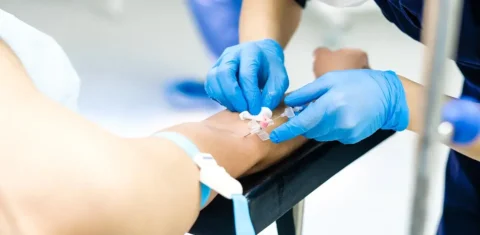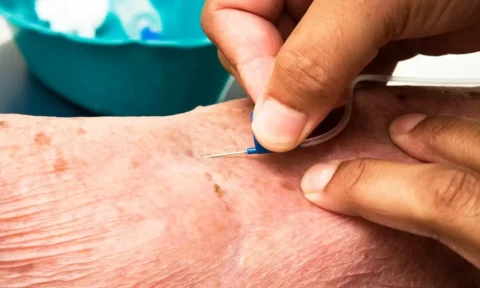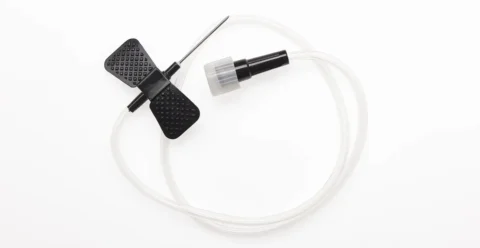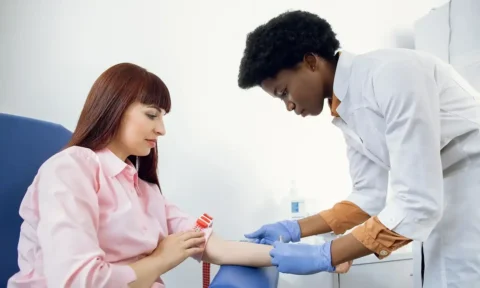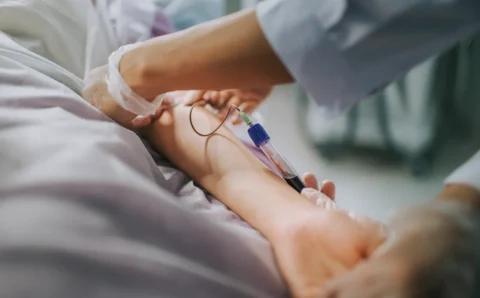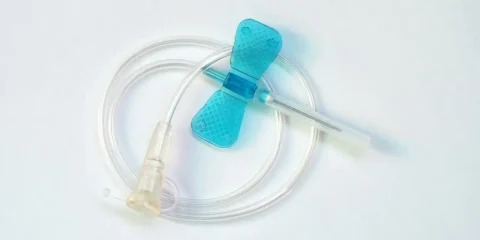Not all needle devices are used for quick injections. These medical instruments can also be used to facilitate blood test collection, medicine delivery, and IV infusion. Among the variety of needles that can be used by a healthcare professional, winged infusion sets are one of the most versatile tools that have multiple applications. However, if you’re using a butterfly needle, it’s important to take note of how long you’re leaving it inside the vein.
So how long should a butterfly needle be inserted in a vein? It depends on the purpose of usage of the butterfly needle. If you’re doing a specimen extraction, butterfly needles should be left inside the vein for a few minutes until the blood work is complete. They can also stay in the vein for at least 5 to 7 days for the administration of IV fluid and medication as long as they’re properly secured.
How Long Can You Leave A Butterfly Needle In The Vein?
Butterfly needles, or winged infusion sets, are specialized medical devices that are a popular option for venipuncture procedures. It consists of a thin, hypodermic needle with plastic wings on both sides which gives it its unique name. Most sets also come with elastic transparent tubing and Luer lock or connector that can be attached to a syringe, vacuum tube holder, or extension tubing from an IV bag.
It’s one of the best needle choices when you have to access a fragile or superficial vein that may be challenging to pierce with a straight needle or evacuated tube system. A butterfly needle is typically smaller in size and length than an IV catheter, providing precise and safe access to narrow areas with small veins. It’s also ideal for use in patients with a bleeding disorder such as hemophilia since it lowers the risk of hemorrhage.
While it’s a comfortable needle for most patients, you still have to consider the amount of time that you’re leaving it inside the vein. Some people may still be uncomfortable with the idea of having a needle piercing their body for a longer amount of time than they’d like to. Normally, the type of procedure will determine how long you need to place the butterfly needle inside the vein.
For Geriatric or Pediatric Blood Collection
A phlebotomist can use a butterfly needle to extract a certain volume of blood from a patient for laboratory testing. It can also be used to get blood for donation since it can be easily connected to another tubing that collects blood. In these circumstances, butterfly needles will need to be left inside the vein until the required quantity of blood sample is acquired.
Normally, a blood draw using a straight or larger needle can take less than 2 minutes. However, a venipuncture procedure with a butterfly needle may take longer since the needles are smaller in size. Meanwhile, collecting for blood donation can take about 15 to 20 minutes since it needs a larger volume, approximately 500 ml of specimen.
How to Use Butterfly Needle for Blood Collection
When using winged infusion sets for a blood draw, you need to prepare the blood collection tube or syringe where the specimen will be stored. You should also keep your gloves, disinfecting equipment, and phlebotomy tray by your side to make the whole process easier. Here’s an overview of the steps for blood collection with a butterfly needle:
- First, place the patient’s forearm in a slightly bent, downward position. You can use an armrest for support to make it comfortable for the individual.
- Visually look or palpate for the vein where you’ll insert the butterfly needle. A tourniquet can be tied to help you select the proper vein. You may also wipe the skin with a clean pad soaked in alcohol to make the veins more visible.
- Once you’ve found a vein, release the tourniquet to allow blood flow to return to normal. Disinfect the selected insertion site with 70% isopropyl alcohol solution and allow the area to dry.
- Put on your gloves and attach the butterfly needle to the tube holder. Reapply the tourniquet at least 2 to 4 inches from the insertion site to help increase venous filling for easier blood collection.
- Lightly anchor and stretch the skin to allow the needle to enter with less pain. Butterfly needles should be inserted at a shallow angle of 10 to 15 degrees in the vein. Once you see a flash of blood in the needle hub, it means you’ve successfully created venous access and you can put a collection tube in the holder to start blood collection.
- The whole blood collection process with a butterfly needle can take several minutes. When the vacuum tube has been filled up, remove it from the holder to stop the blood flow.
- Take a clean gauze pad and immediately place it over the site as you remove the butterfly needle. Activate the safety device as you retract the needle to prevent accidental needle sticks.
- Discard the blood collection set in the sharps container then label the tubes.
For IV Medication or Infusion
Providers can also use a butterfly needle for intravenous therapy to deliver fluids to dehydrated patients. It can also be used to administer medication when an individual has a hard time taking oral drugs or if they need immediate therapeutic relief.
Butterfly needles for IV infusion and medication can stay inside the vein for about a week, provided that they’re securely attached to the patient’s arm. However, longer infusions or regular treatments may already require a central catheter line that is inserted through a bigger vein. It’s important to consider the frequency of IV treatment before deciding whether to use butterfly needles for the infusion or medication.
How to Use Butterfly Needle for IV Infusion or Medication
The butterfly needle should be attached to an extension tubing that’s connected to the transfusion or infusion bag. This will assure that the connection is secure and help avoid needlestick injuries if the bag or tubing gets accidentally pulled or dropped. Here’s an overview of the steps for using a butterfly needle for IV fluid or medication treatments:
- Take the winged infusion set and attach its tubing to the transfusion or infusion bag.
- Look for an appropriate vein and cleanse the insertion site with an antiseptic solution.
- Place the butterfly needle at a shallow angle and you’ll see a flash on the transparent hub.
- Lower the needle until it’s flush against the skin and completely inside the vein. Use the flexible wings to stabilize the needle once it’s inserted in the vein.
- Get a tape to secure the catheter and administer the infusion or medication.
- Once the administration of medication is complete, remove the tape and the catheter. Follow the proper retraction instructions to ensure the safe removal of the butterfly needle.
Why Should Overuse of Butterfly Needles Be Avoided
Although butterfly needles are safer to use than other devices, they still come with some risks of percutaneous needle exposures and sharp injuries. It’s important to avoid butterfly needle overuse to lower the occurrence of needle stick injuries and accidents. Poor insertion technique during venipuncture may also lead to vein collapse, pain, and profuse bleeding if the butterfly needle stays too long under the skin.
In addition, butterfly needles shouldn’t be reused after a venipuncture procedure. Once it has been retracted, it should immediately go to sharps disposal to reduce the risk of transmission of infectious diseases. Unintended needlestick injury or the reuse of butterfly needles may spread hepatitis C and hepatitis B viruses, HIV, syphilis, and malaria. You should make sure to follow the best safety protocols in butterfly needle usage to avoid these complications.
What’s The Difference Between A Butterfly Needle and Scalp Vein Needle?
Butterfly needles and scalp vein needles are essentially the same thing. Aside from being known as a winged infusion set, this blood collection system is also commonly called a scalp vein set. With its hollow needle, it can also be inserted into the delicate veins in the hands, feet, and scalp.
It offers several advantages over the regular needle and evacuated tube systems. Here are some of the known benefits of butterfly needles:
- Makes the infusion or blood collection procedure less painful and more tolerable for patients
- Ideal for use in patients who are scared of larger needles
- Allows for flexible, angled insertion with its slender plastic tubing
- Features a safety mechanism to reduce the likelihood of needlesticks, nerve injury, and bruising
What’s The Most Commonly Used Gauge for Butterfly Needle Size?
Another advantage of butterfly needles is that they come in various sizes and gauges. Its measurements typically range from 18- to 27-gauges. Higher numbers typically indicate smaller dimensions and needle sizes.
If you’re taking a blood specimen, it’s recommended to use 21- to 23- gauges which have a thicker size and allow more blood to be collected faster. Meanwhile, bigger gauges, such as the 27G butterfly needle, are typically used for injections.
Butterfly needles also have a variety of tubing lengths, ranging from 8 to 15 inches. Venipuncture procedures normally require shorter tubes, while IV infusions and administration of medication may need longer tubes to be connected to the bag.
Buy Butterfly Needles and Other Medical Supplies at FACE Med Store
Butterfly needles are helpful for safe and convenient blood collection or IV infusion. However, you should be mindful not to leave the needle in the vein for longer than the procedure requires to avoid the risk of nerve damage and injuries. Ideally, you should closely monitor the blood draw and IV delivery so you can remove the needle as soon as the procedure is complete.
FACE Med Store is a reliable provider of high-quality tools and equipment for medical and aesthetic practices around the United States. We also offer winged infusion sets with different gauges and tubing lengths for your needs. Call us today to inquire about our stocks or browse our website to view our other products.
